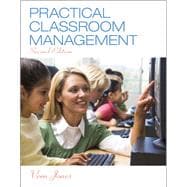NOTE: Used books, rentals, and purchases made outside of Pearson
If purchasing or renting from companies other than Pearson, the access codes for the Enhanced Pearson eText may not be included, may be incorrect, or may be previously redeemed. Check with the seller before completing your purchase.
This package includes the Enhanced Pearson eText and the loose-leaf version
Succinct, Practical, Interactive, Real. Practical Classroom Management focuses on providing clear and concise descriptions of research-validated best practices. It describes and demonstrates how to effectively apply those practices and includes tools like action plans, forms, and checklists that can be used in real classrooms. Case studies and embedded classroom management simulations provide opportunities to practice concepts and strategies discussed in the text, making for a powerful learning experience that students can transfer to the classroom. The Enhanced Pearson eText features interactive learning modules, classroom simulations, and assessments.
Improve mastery and retention with the Enhanced Pearson eText*
The Enhanced Pearson eText provides a rich, interactive learning environment designed to improve student mastery of content. The Enhanced Pearson eText is:
- Engaging. The new interactive, multimedia learning features were developed by the authors and other subject-matter experts to deepen and enrich the learning experience.
- Convenient. Enjoy instant online access from your computer or download the Pearson eText App to read on or offline on your iPad® and Android® tablet.*
- Affordable. Experience the advantages of the Enhanced Pearson eText along with all the benefits of print for 40% to 50% less than a print bound book.
*The Enhanced eText features are only available in the Pearson eText format. They are not available in third-party eTexts or downloads.
*The Pearson eText App is available on Google Play and in the App Store. It requires Android OS 3.1-4, a 7” or 10” tablet, or iPad iOS 5.0 or later.
0133830861 / 9780133830866 Practical Classroom Management, Loose-Leaf Version with Enhanced Pearson eText -- Access Card Package
Package consists of:
- 0133367053 / 9780133367058 Practical Classroom Management, Loose-Leaf Version
- 0133551288 / 9780133551280 Practical Classroom Management, Pearson eText -- Access Card
From reviews of the book:
“The writing is on level and easy to comprehend. . . . The key strengths of the project include research-based text as it relates to ‘practical classroom management,’ supported by examples from real classrooms. . . . The author provides the information in a logical sequence that is fitting for any classroom management course.”
--John Barbato, University of South Florida
“[The text] has examples and forms that I encourage my students to keep....Using this text, preservice teachers are exposed to strategies that are practiced in classrooms and problems associated with the dynamics of implementation.”
--Antwuan Stinson, Alabama State University








